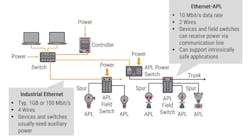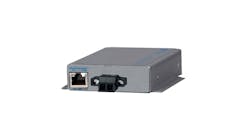Thanks to its far greater speed, Ethernet-APL can connect to more sensors, transmitters and other field devices, depending on what their existing DCS interface can handle. This is why four standards development organizations (SDO), FieldComm Group, ODVA, Profibus-Profinet International and the OPC Foundation, partnered with 12 suppliers to develop it.
FieldComm Group on the essentials
“Anything that moves over Ethernet wiring and uses its protocols can also use Ethernet-APL, so it’s not limited to simple communication and control. It can relay alerts and alarms, perform equipment monitoring, provide motion data, deliver video, and network into hazardous areas with an eight-port switch,” says Paul Sereiko, marketing and product strategy director at the FieldComm Group. “Traditional instruments have one network trunk for dumping aggregated data and another for sending images from cameras watching vats or other equipment, and each needs its own dedicated wire bundle. Ethernet-APL can connect to all of these using the same network it uses for switches, and save all the time, money and labor required to set up and maintain separate networks. Ethernet-APL will be dominant in the process industries because it provides all the speed and benefits that different applications need, but users only have to run wire once, and can also reconfigure and rearchitect for new designs over time.”
Because it can run on existing Ethernet cabling, Ethernet-APL needs that infrastructure to reach in-place instruments. If they have Ethernet, users can test and deploy Ethernet-APL. If not, they have to work with their usual patchwork of networks, and should expect to add an adapter card to let older devices use Ethernet-APL, according to Sean Vincent, technology programs director at the FieldComm Group (Figure 1).
“There are two sides to consider in any automation decision. The first is asset management, and Ethernet-APL can provide many benefits here. The other is controls and operations, and users adopting Ethernet-APL are beginning to report on what it’s doing for them,” says Vincent. “Ethernet-APL is like the new kid replacing 4-20 mA and HART. It’s exciting because Ethernet-APL also gives users the opportunity to replace traditional current loops, even if it takes a while to overcome some infrastructure hurdles.”
A little history from ODVA
Just like any multi-year, overnight success, Ethernet-APL’s present innovations and momentum are just the latest news in a longer and older story.
“The inspiration for Ethernet-APL comes from seeing digital transformation elsewhere and the increasing need to connect devices in the process industries at higher speeds and greater bandwidth, as well as reach to edge devices and hazardous areas where Ethernet hasn’t gone before,” says Al Beydoun, president and executive director of ODVA. “However, there have been some challenges along the way, such as shifting from four or eight wires to using only two to reach field devices. Likewise, getting Ethernet into hazardous locations meant complying with the process industries’ requirements for intrinsic safety by defining specifications for appropriate power classes, and developing conformance tests based on common process operations.”
This is why Ethernet-APL had to be a specific application of the IEEE 802.3cg single-pair Ethernet (SPE), which is defined as 10Base-T1L for 10 Mbps at up to 1,000 meters. “Previously, we had long cable runs in process applications and faced hazardous conditions when trying to deliver power to the field, and this led to many complex wiring schemes,” explains Beydoun. “Now, with Ethernet-APL, we have two wires that can go up to 1,000 meters, and run at speeds up to 10 Mbps, which allows seamless data loading.”
While different devices and protocols can run on the same physical network with Ethernet-APL as they do with regular Ethernet, Beydoun acknowledges they don’t provide immediate, plug-and-play interoperability. However, he adds that protocols like EtherNet/IP, Profinet, Foundation Fieldbus and others can talk to each other via gateways and converters that can translate their conversations and data.
“Users no longer need to run multiple networks, and they can benefit from testing to ensure that Ethernet-APL is safe,” says Beydoun. “To learn about and begin implementing Ethernet-APL, we recommend visiting the Ethernet-APL.org website, and reading its “Ethernet to the field” whitepaper and engineering guidelines. Users can also work with the Ethernet-APL organization’s four SDOs on how to implement it safely in their individual IS processes. Ethernet-APL will let them perform remote commissioning and digital troubleshooting, diagnostics and analytics, so they can detect upcoming failures and maintenance issues earlier, but without all the old, complex networking.”
Beydoun adds that Ethernet-APL’s speed will also let users reduce device configuration times from several minutes each to just a few seconds, and monitor out-of-range operations and premature failures that could impact end-product quality or increase unplanned downtime. “Overall, Ethernet-APL will emerge as vendors implement its physical layer on their products, and then work with system integrators and end users to reach all the components in their processes and plants. With EtherNet/IP sitting on top of this physical layer, Ethernet-APL gives user the full capabilities of EtherNet/IP, including its CIP Security and CIP Safety network extensions. It’s also nice that Ethernet-APL allows potential reuse of Type A fieldbus cables, but users should retest them to verify they have the 100 ohms of resistance (± 20 ohms tolerance) that the standard requires.”
Profinet shows how to remove limits
“Ethernet-APL is the holy grail of bringing Ethernet to instruments in explosive and hazardous areas,” says Michael Bowne, executive director of Profibus & Profinet International (PI) North America. “With typical four-wire Ethernet, installations in hazardous areas often require specialized equipment such as Ex-d housings, so Ethernet wasn’t used in these areas. This is because Ethernet simply carries too much power.”
Bowne reports this is why PI, the three other standards organizations and a dozen manufacturers spent the past several years building Ethernet-APL on top of the IEEE’s existing 802.3cg 10BASE-T1L single-pair Ethernet (SPE) standard. It adds power restrictions defined by IEC TS 60079-47 technical specification for two-wire IS Ethernet (2-WISE) for trunks up to 1,000 meters and spurs up to 200 meters. Ethernet-APL also follows power guidelines for spurs, so users don’t need to worry about possible ignitions or loss of performance.
“One of the most essential tasks for implementing Ethernet-APL is getting rid of the attitude that ‘we can’t do Ethernet,’” says Bowne. “It’s important to get an Ethernet infrastructure in place because there are soon going to be many Ethernet-APL devices available from a variety of manufacturers. Likewise, if you already have Profibus-PA, Ethernet-APL is designed to run on the same Fieldbus Type A cable, so you won’t need to remove those wires.”
“The beauty of Ethernet-APL is that it’s just Ethernet, so users can utilize its 10 Mbps to do things like access to an instrument’s embedded webserver,” adds Bowne. “When employing HART, for example during configuration, its 1.2 kbps means long commissioning times. Using Ethernet-APL for configuration will save hours on commissioning time alone, and enable users to access, gather, and transmit parameters much more quickly.”





